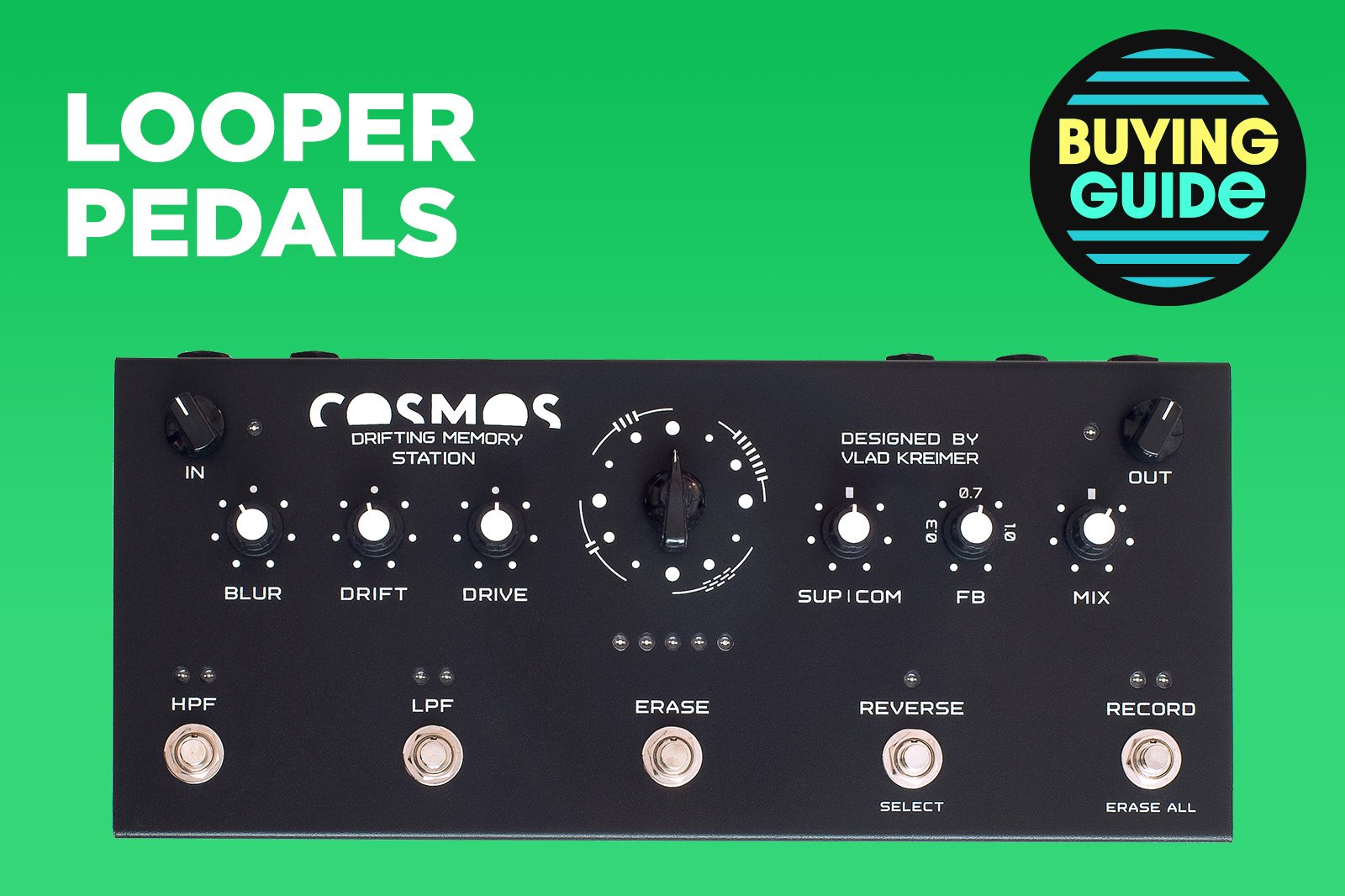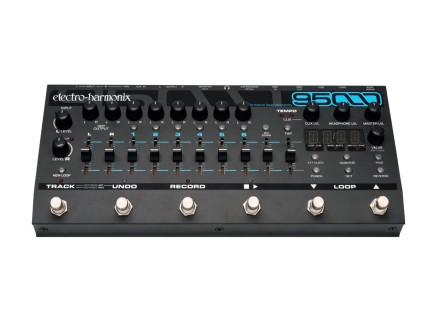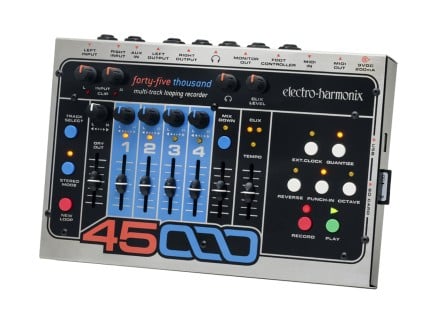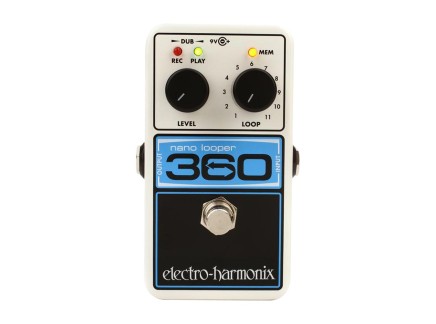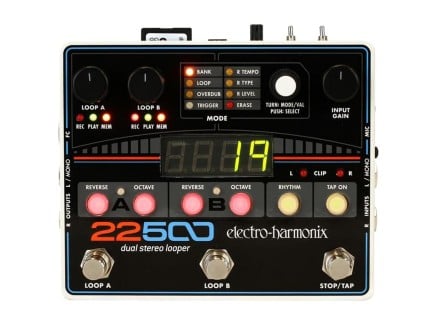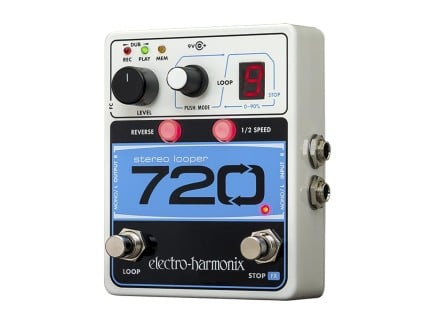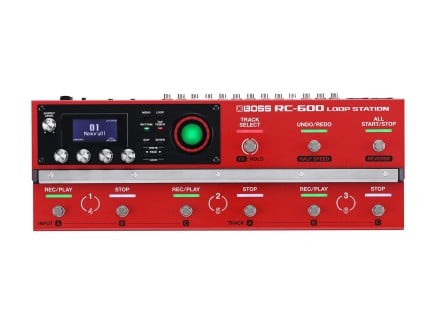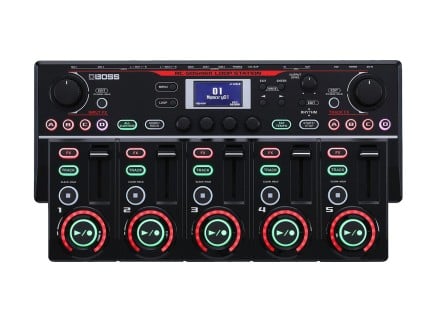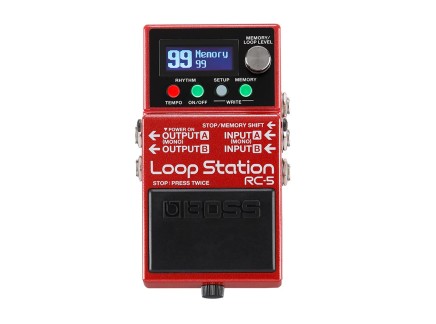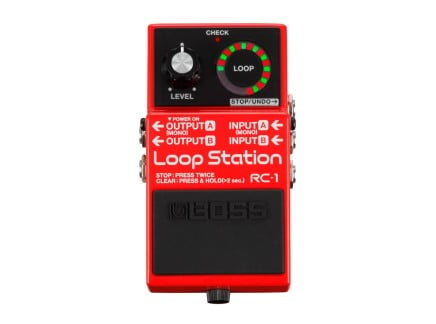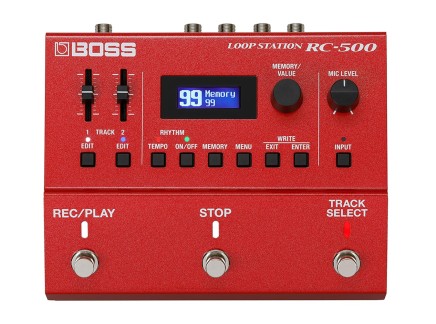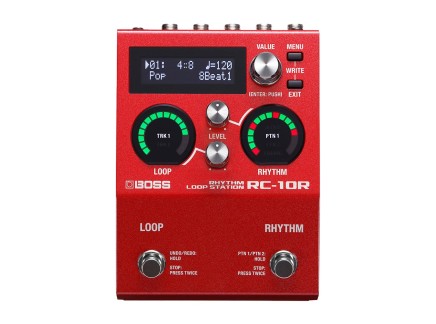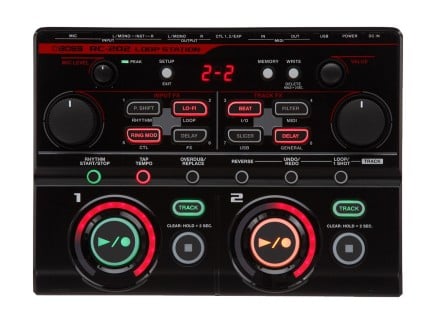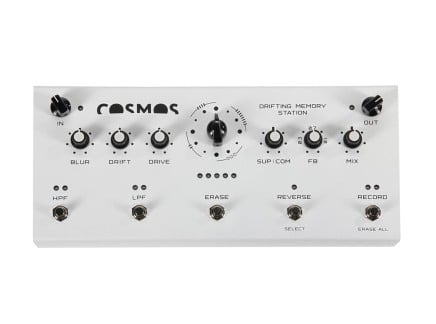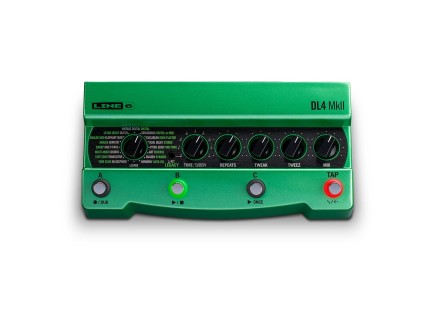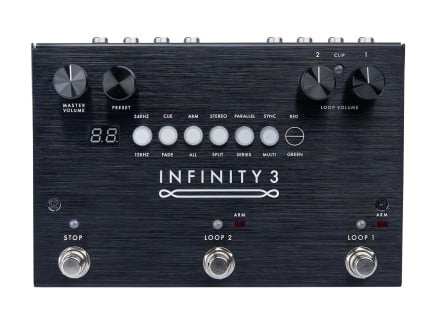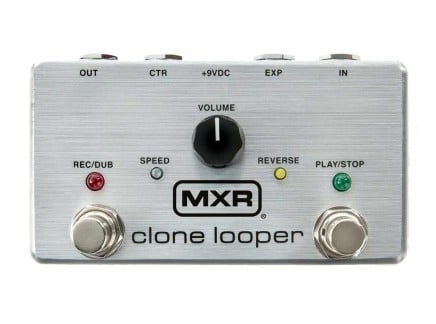Looper pedals are one of the most unique types of processors. They let you layer sounds in an organic way, and there’s a lot you can do with them—especially with some of the more advanced models. They're most commonly treated as guitar pedals, but with some inventive engineering they can work with any type of signal.
The idea sort of has its origin in an early form of multitrack recording—which at the time of its inception the famous Les Paul called "sound on sound." By looping take on top of take in real time, one person could create textured parts to creates a wall of sound...imitating the sound of an ensemble, or creating entirely new sonic structures.
These are some of our favorite looper pedals. Ranging from the insane to the ordinary, if you’re looking for one to live on your pedalboard, you’ll find it here.
Workhorse Loopers from Electro-Harmonix
Electro-Harmonix 95000
EHX’s 95000 is not for the uninitiated. This is a full-tilt looping station designed for only the most serious players. It offers a wealth of features that make it one of the most robust looper pedals on the market. Six-track looping allows for the recording of 100 loops over 375 minutes of recording time. That’s insane.
Some loopers are difficult to use live, but thanks to the 95000’s microSD function that’s not a concern. Through the card you can save your loops for instant recall. This is a really useful feature for live work, as you don’t have to set up the loop in the moment, and avoid the potential mistakes and errors that come with it.
Tap tempo lets you sync the loops to a specific BPM, even if they’re recorded at another tempo. So if you come up with a riff you like, you can fit it into pretty much any song. There’s a speed control that adjusts across a range of two octaves, and the overall loop volume can be set through an external expression pedal.
It’s not just for guitar pedals either. The inputs are a combo XLR/TS standard, with dual 1/4” outputs. There are also MIDI inputs and outputs and a USB type B connection. Through the USB connection you can import and export .WAV files. This means you can take your recordings, throw them into your DAW for processing, and load them back into the pedal.
The layout may be daunting at first glance, and there will be a learning curve to using it. But once you understand how to get the sounds you want out of it there might not be a more powerful looper pedal that can compete with it. It’s probably too much if you’re looking for something to just lay down some simple loops. But if you’re looking for a model with almost no limitations, the 95000 is it.
Electro-Harmonix 45000
EHX is known for some innovative pedal designs, and their selection of loopers is no different. The 45000 is something like a simpler/pared back version of the 95000. It’s almost more of an audio workstation than looper thanks to a variety of digital recording features.
All four loops offer four mono tracks that flow into a stereo buss for mixing. The digital recorder operates on CD-quality 16-bit/44.1kHz settings. While higher sample rates might be nice, this standard is compatible with basically everything—and makes file transfer a breeze. It records directly to SD card flash memory. 100 loops can be stored on each 4GB card, with a max recording time of 125 minutes. You can toggle through them using the optional foot controller (sold separately). They can also be bounced to .WAV files for further editing.
It can record as well as play in reverse, and the loop speed is adjustable across two octaves.To make sure your timing is spot on, there’s an internal metronome that you can send out to headphones or monitors and optional quantization.
The optional foot controller allows you to set parameters in real time with greater ease—especially if your hands are occupied while playing. It controls transport, as well as selecting between different loops and tracks. An LED readout tells you what loop number you’re on, and it’s easy to see in dark settings.
If you’ve ever used a 4-track recorder like the old Tascam models, it shouldn’t take you long to get running with the 45000. There aren’t any advanced features like onboard effects, but what it does, it does really well. Through MIDI clock sync you can slave it to other gear or use it as a master.
EHX offers several other loopers as well, so you can find the one that best fits your sound and budget. If you still want some of the more advanced features, look into the 22500 or 1440. And if you’re looking for a standard guitar pedal size, the 720 and 360 are it. They all offer great features that fit your needs, and range in price from approximately $125 for the 360 up to around $320 for the 22500.
Workhorse Loopers from Boss
BOSS RC-600
If you’re looking for a looping control center, the RC-600 is one of the best choices. It’s powered by 32-bit onboard effects and lets you record six stereo loops with assignable effects for each. 99 memory banks let you store loops for instant recall, and everything can be monitored through the LED readouts with a loop status indicator that helps to make your recordings more precise.
The six footswitches are assignable over three pedal modes. Two external control inputs allow for a unique way to set the parameters of loops in real time. The I/O section is one of the most advanced in its class, with combination XLR-1/4” inputs and three assignable 1/4” outputs.
BOSS is one of the industry leaders in effects, and the 32-bit onboard effects that come built into the RC-600 give you a number of ways to augment your sound. There are 49 input effects and 53 effects types, and up to four of them can be used on each loop.
In the world of loopers, there are multi-effect pedals that offer basic looping functions—but then, there are dedicated looping workstations. The RC-600 is the latter. If you’re serious about looping, this one of the best choices. The easy I/O options, onboard effects, and the ways it aids in looping through the loop status indicator make this a no-brainer if you’re looking for a full looping control station.
BOSS RC-505 mkII
The pedal maestros at BOSS offer one of the most robust loopers available in the RC-505 mkII. It’s not just a standard pedal, it’s yet another full-tilt looping station. With it, you get five loop tracks with independent level and transport controls as well as effects.
Since BOSS is one of the kings of the guitar effects market, the RC-505 includes ways to augment your loops like delay, reverb, even slicing. You also get some legendary BOSS effects like the Slow Gear and ring modulator. Effects can be used on the way in or applied after your loops are laid down, with three usable at once. The effects section is anything but basic, and BOSS jammed the same versatile control sets into it like you find on their individual pedals.
Some loopers can be difficult to use, and if you’re not spot-on with your timing and playing it can be frustrating to get things just right. The RC-505 takes a lot of these headaches away, with long throw faders and functions that let you edit and change things up easily. Controls can be mapped and set up 16 parameters and control them through MIDI and each loop can be quantized for putting things together quickly. Running out of room for presets isn’t a concern, with 99 available banks. You can also choose between 85 rhythm patterns to keep things interesting.
Looper pedals aren’t just for guitar, so a versatile and robust I/O section is a must. There are dual XLR inputs with on-deck phantom power as well as instrument inputs that work in mono or stereo. External control is offered through an expression pedal, external footswitches, and MIDI. This second version of the 505 also offers a larger display in addition to more preset banks, onboard effects, and more intuitive I/O. It has DAW integration too, and it can output audio through the USB port.
The RC-505 is a full-featured powerhouse of a loop station. It’s much more than just a guitar pedal, and it’s just as useful in the studio as it is on the stage. The faders are a nice tactile touch and the effects section offers a diverse range of BOSS sounds. It comes in at a high price point for a looper, but if you need a model that offers easy ways to edit and process audio this is one of the best.
BOSS RC-5
Another great entry-level option from BOSS is the RC-5. It offers the same stereo I/O, but comes with a number of additional features.
It offers 13 hours of recording time, 99 preset slots for storing sounds, and you can even throw the loops in reverse. But BOSS added some arranger functions that include seven drum kits and 57 rhythms to help build out your sounds, and each offers an A/B variation.
You can control everything from the front like any guitar pedal, and these controls are extended if you use a footswitch or expression pedal. There’s also MIDI control that’s accessible via 3.5mm jacks on the rear.
The RC-5 offers a lot of functionality in a pedalboard-friendly size. It’s streamlined for live use, but the arranger features make it a great songwriting tool. It’s perfect for constructing simple loops, and it’s really cool that you have the option of creating an entire song with it.
BOSS RC-1
BOSS's most basic looper pedal doesn’t offer the options that the larger ones do, but that doesn’t mean it’s underpowered. And of the entire RC line, it’s the easiest to use: so if you need a no-nonsense, straight-to-the-point looper, RC-1 might be just the thing.
Loops can be recorded in stereo for up to 12 minutes, and you get unlimited overdubs. Through an expression pedal you can control the Stop and Undo when recording new loops. There’s an easy to read visual that lets you know the loop position, and a level control for getting the perfect mix blend. Even better, you don’t have to worry about losing anyting because loops that are recorded stay in the pedal’s memory even after it’s turned off.
The RC-1 is a simple but powerful looper pedal. If you need something that’s compact but has a lot going on under the hood, it’s perfect for players who want to start experimenting with looping. The RC-1 is a great, affordable choice.
BOSS offers a number of other models in the RC line. The RC-500, RC-10R, and RC-202, for instance, all offer features that any guitarist looking to get into looping will appreciate. They're similar to those devices we've already discussed, each with a slightly different feature set and price point.
Experimental Loopers
But of course, some players don’t want a clean looper—they want something that’s going to inspire them by mashing up their sounds in the best ways. These are some of the best experimental loopers, and they can do some beyond crazy things.
SOMA Laboratory Cosmos
Are you a fan of esoteric, mangled looping sounds? The Cosmos Drifting Memory Station will dismember audio in the best ways. There’s nothing clean about it. It’s a dynamic looper that offers evolving sounds, not the clean, static looping we’re all used to.
The DSP runs at 32-bit/48kHz to offer four different sounds across a 44.7 second loop memory. It’s got an interesting switching system that’s based on five footswitches. It has a unique way of handling transitions between the different loops due to the crossfading it provides.
As far as layout goes, the controls are logical considering what it’s capable of. There’s a central control knob and four additional knobs on either side. The EQ section is no joke either. The low and high-pass filters both have three different cutoff frequencies. A reverse switch lets you switch up the incoming audio, and you can duck sections of the loop in real-time through the Erase switch. If you need to start the loop over you can use it to take out the memory buffer by hitting it twice.
A pedal this unique has got to have features you don’t usually find in a looper, right? You can add distortion, control dynamics with a pseudo-compressor effect, and input and output gain ensure your gain staging is spot on.
It might be called a Drifting Memory Station, but what this looper pedal does to your sound is impossible to forget.
Line 6 DL4 MkII
The first DL4 was released in 1999. Today we take it for granted, but back then it was a revolutionary concept for a digital delay to offer so many great sounds, including analog models, all in a unit that offers multiple presets. It was an instant sensation, a hit among pro and amateur guitar players alike. Despite intermittent production toward the end of its life span, the DL4 was still highly sought after on the used market. The best part was that there are so many of them out in the world that the lack of supply never really thinned, even as demand stayed steady. This meant their monetary value never skyrocketed, but their sonic value continued to prove its credibility.
So what’s new with the Line 6 DL4 MkII? The enclosure is more streamlined than the previous version. It’s the same layout, but it’s sleeker and more ergonomically shaped. It offers a total of 30 distinct delays, half from the first model and 15 new sounds. Even better, there are 15 reverbs that you can use in tandem with the delays!
While Line 6 added new sounds, a slightly different look, and improved everything overall, you’ll notice the biggest difference in how the looping function works. Transport is set through the footswitches, and the looping section can be used with all four switches to layer things.
It offers up to 240 seconds of loop time, and it can be expanded by using a microSD card. Things get even more interesting when you use the performative looping options. It lets you switch sounds up to half-time or reverse things altogether—a trick heard in music by experimental rockers like Minus the Bear's Dave Knudson, Nick Reinhart of Tera Melos and Disheveled Cuss, and composer/guitarist/synthesist Tyondai Braxton.
The Line 6 DL4 mkII doesn’t slack on routing and expression features either. Stereo I/O, MIDI control, and expression or external footswitch input means it will find a home in any rig and appeal to all types of players.
Maneco Labs Sixteen Seconds Delay
With a retro aesthetic, the Sixteen Seconds Delay immediately stands out on first look. And there’s a reason for that. It’s a reissue based on the venerated Electro-Harmonix 16 Second Digital Delay—and an outgrowth of their past work with the Sweet 16, a somewhat simpler re-imagining of the original.
The control set is where the magic of the Sixteen Seconds Delay really unfurls. Five sections (Delay, Sweep, Clix, Mix, and Vent) and the corresponding sliders adjust parameters like rate, depth, harmonics, feedback, and wet/dry blend.
The routing offers a unique configuration. You can connect external footswitches to control how fast the delay is, as well as controlling forward or reverse playback. You can output the clock to other gear, but the pedal is mono only. There’s even an onboard metronome to make sure you stay in the pocket!
The original EHX pedal was one of the first compact digital loopers available altogether—eventually becoming a staple part of the improvisational setups of experimental musicians like Charles Cohen and Nels Cline. The Maneco Labs reissue is a unique pedal that will appeal to players who are fans of experimental vintage flavors with modern features. The enclosure is larger than some modern pedals, so keep that in mind when thinking about adding it to your pedalboard. But this looper pedal allows for looping parts in unique ways, so it’s great if you’re looking for something to spark creativity.
Conclusion
Looper pedals are a great tool to add to your sound in unique ways. You have a lot of options when it comes to expanding your sound, and loopers are one of the most unique. Whether you want something clean and cutting or a pedal that pushes the limits of your creativity, they provide a great platform for experimentation.
If you need more ideas, be sure to check out our full selection of looper pedals.
Brandon Stoner is a lifelong musician who owns more guitars than anyone needs. Having toured nationally, he is a trained audio engineer that has worked in studios and on stages across the United States. As a lover of all things writing and music technology, he crafts every piece with his dog Max on his lap.

